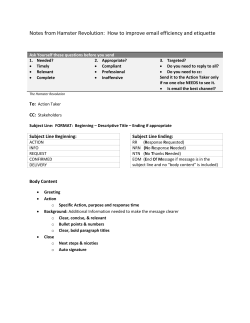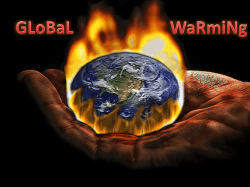
Environmental Impact of the Industrial Revolution Progress Production, Profit, Pollution
Environmental Impact of the Industrial Revolution Progress Production, Profit, Pollution Industrial Revolution Production and Profit • Massive increase in energy use from burning fossil fuels. • Agrarian to industry-based economy • Rapid and large increase in production of goods • Sustained population growth with movement from farm to urban centers • Improvements in transportation, agriculture • Increase the standard of living http://www.ecology.com/features/ind ustrial_revolution/index.html Industrial Revolution Pollution • • • • • • Air pollution Water pollution Global warming Acid rain Deforestation Ecosystem destruction Overview • THE ENVIRONMENTAL IMPACT OF THE INDUSTRIAL REVOLUTION by Craig Benjamin • www.muskegonisd.org/downloads/dept/envir o_impact_of_ir.ppt Air Pollution • Particulates from burning fuel and from volcanoes [today also: power plants, auto emissions] • Gas emissions from burning fuel and from volcanoes [today also: power plants, auto emissions, industry] – CO2: from combustion of fossil fuels by motor vehicles, power plants – SO2: from burning fossil fuels, esp coal (90%), volcanoes, wildfires – NO, NO2: from burning fossil fuels, esp coal – [CFC (chlorofluorocarbons): now mostly banned] Detrimental Impact of Air Pollution • Production of acid rain • Respiratory problems and disease in humans (1952 great London smog killed 4000) • Chemical corrosion of buildings and statues • Stresses plants (smog reduces sunlight and therefore photosynthesis) and animals Acid and pH • Acids donate H+(aq) ions in water. The more H+(aq) ions present, the more acidic. • pH is a measure on the strength of the acid. The pH range is 1-14 with pH 7 being neutral. • Unpolluted rain has pH 5.2-5.3 (slightly acidic; the pH of coffee is @4.8) due to the presence of CO2. • The pH of acid rain has been measured as low as 2.4. Acid Rain • Precipitation (rain, snow) that contains acids formed from the reaction of human generated air pollutants, oxygen and water. – SO2 (g) + ½ O2 (g) + H2O(g) H2SO4 – 2NO2 (g) + ½ O2 (g) + H2O(g) 2HNO3 – 2NO (g) + 3/2 O2 (g) + H2O(g) 2HNO3 • Note that CO2 is naturally present in the atm. – 2CO2 (g) + 2H2O(g) 2H2CO3 Detrimental Impact of Acid Rain • Vegetation suffers due to an increase in mineral leaching at higher acid levels • Microbes in the soil are killed • Insects suffer evolutionary changes; higher food chain members are affected • Aquatic species populations are stressed as oceans become more acidic • Buildings and statues are chemically corroded Acidification of the Lakes, Streams and Oceans • Healthy lakes have pH 6.5; at pH 4, the lake is dead. • Healthy oceans have pH 8.2; current pH 8 • The presence of excess H+(aq) causes – Dissolving/deterioration of seashells – Fish eggs that do not hatch (< pH 5) – Increase in [Al+(aq)] decrease in fish – Decrease in biodiversity Global Warming • The increase in the average temperature of the earth’s oceans, land and surrounding air. • Also called climate change. • Depends on incoming and outgoing solar radiation, wind and water currents, atmospheric gases, clouds, volcanic gases and human activities. • Car example Greenhouse Effect • Solar radiation – 30% reflected by atmosphere, clouds, dust – 25% absorbed by atmosphere – 45% absorbed by land and oceans • • • • Some heats the land and oceans Some is radiated back into the atm as IR radiation 19% escapes out of earth’s atm 81% is absorbed by greenhouse gases and re-emited, thus warming the earth’s surface even more. Enhanced greenhouse effect is the problem http://www.bbc.co.uk/climate/evidenc e/greenhouse_effect_img.shtml • Animation from the BBC Greenhouse Gases GWP: Global Warming Potential: effectiveness in absorbing IR radiation; measure of contribution to Global Warming Chemistry in Context, 2006, Am. Chem. Soc Increase 1750-2000 Persistence GWP CO2 33% 5-200 yr 1 CH4 160% 12 23 N2O 10% 114 296 http://en.wikipedia.org/wiki/Greenho use_effect Detrimental Impact of Global Warming • More precipitation in some areas flooding • Less precipitation in others spread of deserts, change in crops • Melting of ice caps rise of sea level • Spread of diseases • Changes in ecosystems (e.g. Ocean warming) • Weather pattern alterations • Reduced biodiversity Water Pollution • Water covers 70% of the earth. • Much water is held in aquifers – ground water • Sources: industrial waste (heavy metals, phosphates, asbestos, nitrates, solvents, petrochemicals), fertilizers and pesticides, untreated sewage, oil spills, dumping in oceans, acid rain, underground storage leakage. • http://www.water-pollution.org.uk/ Detrimental Impact of Water Pollution • Developmental problems (heavy metals, toxic compounds) • Disease (cholera and typhoid from microorganisms, also organic solvents, asbestos) • Death (see above, also algae blooms and microorganism growth which deplete oxygen in lakes Industrial Revolution • Major turning point in earth’s ecology and the relationship between humans and environment. • The next revolution: Sustainability, a Green Industrial Revolution ? Other Resources • http://www.ace.mmu.ac.uk/esd/Earth/Industr ial_Revolution.html • http://openlearn.open.ac.uk/mod/resource/vi ew.php?id=94546
© Copyright 2025


















